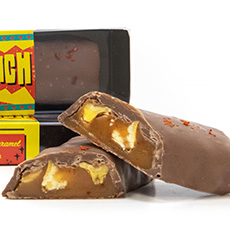|
In Mexico, lucha libre is freestyle wrestling (literally, free fight). It has developed into a stylish form of the professional wrestling, characterized by colorful masks, rapid sequences of holds and maneuvers, and high-flying maneuvers, some of which have been adopted into U.S. wrestling. Gearharts Chocolates has ported the colorful spirit of wresting into a scrumptious chocolate crunch bar, which has become our new favorite candy. The Lucha Crunch Bar is a 5 x 2.5 delight that is not to be missed. The enticing packaging has artwork in Lucha Libre style, including a mask! The luscious, nut-free candy bar inside is filled with Mexican-inspired flavors:
All hail the Heavyweight Champion! Lucha Crunch Bar is our favorite chocolate find of the year. Hopefully, well be able to limit our consumption to one bar per week. |
Get yours at GearhartsChocolate.com.
|
|
|
THE HISTORY OF CANDY BARS The first candy bar was created in 1866. Here are the oldest bars, thanks to Oldest.org, from which this content was adapted. To see photos of the bars, click here.
|
||
STOCKING STUFFER: Lucha Crunch Bar, The Undisputed Champion



Leave a comment